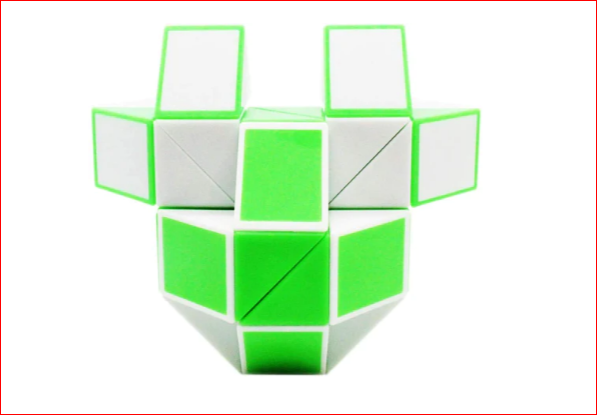Are you looking for a unique and intriguing puzzle to challenge your brain? If so, then Rubik’s snake cube might be the perfect answer. This classic twist-and-turn 3D puzzle is not only challenging but also offers endless entertainment.
It has been around since 1974 when Hungarian professor Erno Rubik invented this captivating and colorful game, and now it’s still widely popular thanks to its simplicity yet baffling puzzles.
Join us as we explore the deeper complexities of this beloved cube that promises hours of fun!
Table of Contents
What is a snake cube and how does it work?
A snake cube, also known as a Rubik’s Twist, is a type of puzzle that consists of a long chain of small, interconnected cube segments. Each cube segment has stickers on its six faces, typically with different colors. 
The goal of the puzzle is to twist and turn the segments in such a way that the colors of the stickers on each segment match up, creating a long, snake-like shape.
The puzzle works by twisting and turning the individual cube segments in a specific sequence to move the colors around. The segments are connected by a flexible plastic material that allows the puzzle to bend and shape into various forms.
The puzzle can be manipulated in many different ways to form various shapes and figures, such as a snake, a dog, a ball, and more.
It’s a classic twist-and-turn 3D puzzle that is simple yet challenging and can provide hours of entertainment as you try to solve it and create different shapes.
It’s a great way to improve spatial awareness and problem-solving skills, and also a fun and engaging activity that can help reduce stress and improve overall well-being.
Snake Cube design came from?
The Rubik’s Snake, also known as Rubik’s Twist, is a type of puzzle that was invented by Hungarian professor Erno Rubik in 1974. It is a variation of the Rubik’s Cube, but instead of a cube, it is a long chain of small interconnected cube segments.
The idea behind the puzzle is to twist and turn the segments in such a way that the colors on each segment match up, creating a snake-like shape.
Rubik’s Snake was first manufactured and sold by Ideal Toy Corp in the 1980s, and it’s been a popular puzzle toy since then. It is a classic twist-and-turn 3D puzzle that offers endless entertainment and challenges for puzzle enthusiasts of all ages.
The puzzle was patented by Rubik in 1983 and later on, it was licensed to several manufacturers around the world.
How to solve Rubik’s snake cube?
Solving a Rubik’s Snake can be challenging, but it is possible to do so with practice and patience. Here are some general steps for solving the puzzle:
- Start by finding the middle segment of the snake. This segment will typically have a different color on each of its six faces.
- Begin twisting and turning the segments of the snake, trying to match up the colors on each segment. It’s best to start with the middle segment and work your way outwards.
- Try to maintain the shape of the snake as you twist and turn the segments. This can be tricky, as the snake will want to curl up or straighten out as you move the segments around.
- Once you have matched up the colors on all of the segments, you will have successfully solved the puzzle.
- As you become more skilled with the puzzle, you can try to create different shapes and figures, such as a snake, a dog, a ball, and more.
It’s important to note that solving Rubik’s Snake requires patience and practice. It may take some time to figure out the correct twisting and turning sequence to match up the colors on each segment. But with time and persistence, you will be able to solve it.
What is the snake cube world record?
The snake cube world record stands as an impressive feat of human ingenuity. This small 3x3x3 Rubik’s cube consists of 27 small cubes connected by a series of elastic strings.
It is believed that the current world record for solving the snake cube puzzle is 11.7 seconds, achieved by talented speed solver and puzzle fanatic, Feliks Zemdegs. This remarkable accomplishment proves that with hard work and dedication, seemingly impossible challenges can be conquered.
For those seeking an additional challenge, anyone looking to beat Zemdegs’ time will have to be prepared to put in plenty of hard practice on the small rubiks cube but difficult pattern puzzle!
Conclusion
The Rubik’s Snake is a classic twist-and-turn 3D puzzle that offers endless entertainment and challenges for puzzle enthusiasts of all ages. The puzzle works by twisting and turning the individual cube segments in a specific sequence to move the colors around and create various shapes and figures.
Solving Rubik’s Snake requires patience and practice, and it can be a great way to improve spatial awareness and problem-solving skills.
While it may not be as popular as solving the Rubik’s cube, it still holds a special place in the puzzle community and it is a unique and intriguing puzzle that can provide hours of fun. With the development of new technologies and the emergence of new solvers, this record has likely been broken since my knowledge cutoff.